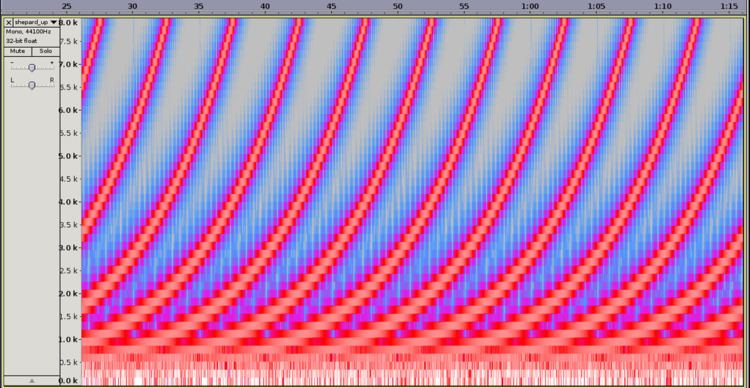 | ||
A Shepard tone, named after Roger Shepard (born 1929), is a sound consisting of a superposition of sine waves separated by octaves. When played with the base pitch of the tone moving upward or downward, it is referred to as the Shepard scale. This creates the auditory illusion of a tone that continually ascends or descends in pitch, yet which ultimately seems to get no higher or lower.
Contents
Construction
Each square in the figure indicates a tone, with any set of squares in vertical alignment together making one Shepard tone. The color of each square indicates the loudness of the note, with purple being the quietest and green the loudest. Overlapping notes that play at the same time are exactly one octave apart, and each scale fades in and fades out so that hearing the beginning or end of any given scale is impossible. As a conceptual example of an ascending Shepard scale, the first tone could be an almost inaudible C4 (middle C) and a loud C5 (an octave higher). The next would be a slightly louder C♯4 and a slightly quieter C♯5; the next would be a still louder D4 and a still quieter D5. The two frequencies would be equally loud at the middle of the octave (F♯4 and F♯5), and the eleventh tone would be a loud B4 and an almost inaudible B5 with the addition of an almost inaudible B3. The twelfth tone would then be the same as the first, and the cycle could continue indefinitely. (In other words, each tone consists of two sine waves with frequencies separated by octaves; the intensity of each is e.g. a gaussian function of its separation in semitones from a peak frequency, which in the above example would be B4. According to Shepard, "(...) almost any smooth distribution that tapers off to subthreshold levels at low and high frequencies would have done as well as the cosine [gaussian] curve actually employed.")
The acoustical illusion can be constructed by creating a series of overlapping ascending or descending scales. Similar to a barber's pole, the basic concept is shown in Figure 1.
The scale as described, with discrete steps between each tone, is known as the discrete Shepard scale. The illusion is more convincing if there is a short time between successive notes (staccato or marcato instead of legato or portamento).
Jean-Claude Risset subsequently created a version of the scale where the tones glide continuously, and it is appropriately called the continuous Risset scale or Shepard–Risset glissando. When done correctly, the tone appears to rise (or fall) continuously in pitch, yet return to its starting note. Risset has also created a similar effect with rhythm in which tempo seems to increase or decrease endlessly.
The tritone paradox
A sequentially played pair of Shepard tones separated by an interval of a tritone (half an octave) produces the tritone paradox. In this auditory illusion, first reported by Diana Deutsch in 1986, the scales may be heard as either descending or ascending. Shepard had predicted that the two tones would constitute a bistable figure, the auditory equivalent of the Necker cube, that could be heard ascending or descending, but never both at the same time. Deutsch later found that perception of which tone was higher depended on the absolute frequencies involved, and that different listeners may perceive the same pattern as being either ascending or descending.
